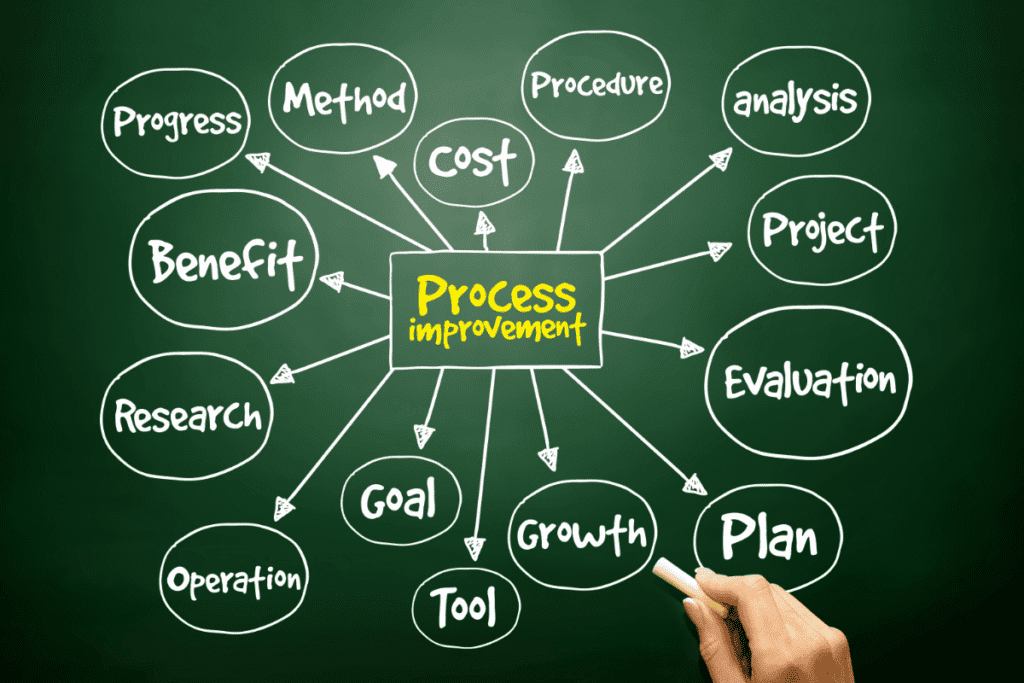Proven Process Mapping: A Six Sigma Approach That Delivers Results
Ever wondered how top-tier organizations simplify intricate procedures and ensure cohesive alignment? Welcome to Process Mapping—a straightforward yet potent technique that goes beyond mere flowcharts for process improvement. Compare and contrast Process Mapping vs Value Stream Mapping so you know when and how to use these useful tools.
This tried-and-true method is not only user-friendly but also exceptionally effective.
Six Sigma is a methodology engineered to improve processes through a data-driven approach that aims to identify and eliminate the causes of errors or defects in a systematic and statistical way. It can be applied to various industries and processes, including manufacturing, healthcare, logistics, and services.
Overall, a Six Sigma program provides a structured and disciplined approach to process improvement, allowing organizations to achieve superior quality and operational excellence.
Integrating the principles of Six Sigma, promises transformative results, guiding you every step of the way toward organizational success.
Explore it further to learn how it integrates with Six Sigma and how it may transform organizational procedures.
What is the Value of Process Mapping?
A valuable technique for visualizing, comprehending, and communicating the numerous processes and complexities of a process is Process Mapping. Its main objective is to deconstruct and clarify the stages involved, promoting transparency and agreement among parties. Although process mapping is not a Six Sigma-only technique, its concepts complement the structured, data-driven approach of Six Sigma and have substantial organizational benefits.
What are the Levels of Process Mapping?
Understanding the many degrees of depth and granularity, each serving a specific audience, is crucial for applying process mapping effectively. This top-down method guarantees that all stakeholders, from senior management to frontline staff, have a comprehensive grasp of the process by starting with an executive overview and advancing to detailed procedures:
- Level 1 – Executive Level Overview: A bird’s-eye view capturing major steps or stages, ideal for senior management to grasp the essence of a process quickly.
- Level 2 – Business Process (The What): A deeper dive into specific steps or tasks, answering the “What” of the process without overwhelming with granular details.
- Level 3 – Detailed View with System Design (The How): A comprehensive map detailing how each step unfolds, highlighting tools, techniques, or methodologies. It’s a roadmap for those directly involved in the process.
- Level 4 – Procedures Level: The most granular level, breaking down each step into its constituent tasks, serving as the foundation for governance, control points, user guides, SOPs, and other detailed documentation.
Most non-practitioners often start at Level 4, as it provides the detailed view they seek when mapping the “As-Is” state. However, for a holistic understanding and effective communication, it’s crucial to traverse through all levels.
What are Some Reasons Not to Start with a Value Stream Map for an Undefined Process?
Why not start with VSM for an undefined process? Six Sigma emphasizes defining before analyzing.
Jumping directly to VSM can be counterproductive:
- Foundational Understanding: A basic process map or SIPOC ensures you don’t miss crucial steps.
- Granularity: VSM is detailed and used to reduce waste. Without a basic flow, capturing this detail can be overwhelming.
- Scope and Boundaries: A high-level map ensures you understand the process’s boundaries.
- Stakeholder Engagement: Starting with VSM can confuse stakeholders.
- Efficiency: Defining the process first ensures a more accurate VSM.
Six Sigma, emphasizes the importance of defining the problem and the process before diving into analysis. By first ensuring a clear and accurate understanding of the process, more effective analysis and, ultimately, more impactful improvements can be realized.
What is the Structure of this Approach to the Lean Six Sigma Methodology?
As we continue our exploration of Process Mapping, let’s now dive into the structured framework that underpins Six Sigma’s success—the DMAIC Methodology. This isn’t just any acronym; it’s a roadmap for achieving process excellence.
In this section, we’ll go into the five key phases of DMAIC: Define, Measure, Analyze, Improve, and Control. Together, we’ll identify the preferred artifacts/process map types, and uncover how each step contributes to the transformation of complex processes into streamlined, efficient operations.
Traceability to Six Sigma’s DMAIC Methodology
DMAIC, pronounced as duh-MAY-ick, is a structured problem-solving methodology widely used in Six Sigma projects to improve and optimize business processes. The acronym “DMAIC” stands for the five phases of the methodology.

Process Steps Overview
1. Define
- Objective: Identify the problem and define the project scope.
- Key Activities:
-
- Develop a problem statement.
- Identify project goals and objectives.
- Define the scope of the project.
- Artifacts: SIPOC, A3 Report or Project Charter
2. Measure
- Objective: Establish a performance baseline and understand the current process.
- Key Activities:
-
- Identify key process metrics.
- Collect data on the current process.
- Validate the measurement system for data accuracy.
- Artifacts: Business Process Diagram (BPD), Detailed Process Flowchart, Current State Value Stream Map (VSM)
3. Analyze
- Objective: Identify and validate the root causes of issues.
- Key Activities:
- Use statistical tools to analyze data.
- Identify potential root causes of variations or defects.
- Validate root causes through data analysis.
- Artifacts: Cause & Effect Diagram (Fishbone/Ishikawa), Future State Value Stream Map (VSM)
4. Improve
- Objective: Develop, test, and implement solutions.
- Key Activities:
-
- Brainstorm potential solutions.
- Evaluate and select the best solutions.
- Pilot test the solutions.
- Implement the solutions.
- Artifacts: Revised Business Process Diagram (BPD), FMEA (Failure Mode and Effects Analysis)
5. Control
- Objective: Ensure sustained improvements and standardize the improved process.
- Key Activities:
-
- Develop control plans to maintain improvements.
- Monitor the process using control charts.
- Train personnel on the new process.
- Document the new process.
- Artifacts: Control Chart, Standard Work (or Work Instructions)
Does the 4-Level Model Align to the Six Sigma Process?
Understanding the process is one thing, but aligning it to specific levels ensures clarity and precision. Let’s see how the various artifacts and objectives fit into our four levels of Process Mapping. This process incorporates basic Six Sigma concepts and should be relatable to the Six Sigma practitioner.
1. Level 1 – Executive Level Overview:
- Objective: Identify the problem and project scope.
- Artifacts:
- SIPOC: Provides a high-level overview of the process, capturing major steps or stages.
- A3 Report or Project Scope Document: Offers a concise summary of the problem, goals, and proposed solutions.
2. Level 2 – Business Process (The What):
- Objective: Establish a performance baseline and understand the major steps or tasks in the process.
- Artifacts:
- Business Process Diagram (BPD): Outlines the specific steps or tasks within a process, answering the “What” of the process.
3. Level 3 – Detailed View with System Design (The How):
- Objective: Delve deeper into the process to identify the root causes of issues and develop solutions.
- Artifacts:
- Detailed Process Flowchart: Provides a more granular view of the process steps and their interactions.
- Current State Value Stream Map (VSM): Captures the flow of materials and information, detailing how each step is accomplished.
- Cause & Effect Diagram (Fishbone): Helps in identifying root causes of defects or variations.
- Future State Value Stream Map (VSM): Visualizes the proposed improvements to the process.
- Revised Business Process Diagram (BPD): Represents the improved process after analyzing and identifying areas of improvement.
- FMEA (Failure Mode and Effects Analysis): Assesses potential risks in the improved process.
4. Level 4 – Procedures Level:
- Objective: Ensure sustained improvements and provide clear instructions for each task.
- Artifacts:
- Control Chart: Monitors the improved process over time, ensuring stability.
- Standard Work (Work Instructions): Offers detailed instructions for each task, serving as the blueprint for the process.
What are the Value-Add Benefits of Implementing Six Sigma Process Mapping for Business?
Dive into the diverse advantages of Process Mapping, a tool that not only clarifies organizational workflows but also fortifies critical areas like governance, risk management, and operational efficiency. Discover how this visual representation becomes a cornerstone for various organizational functions, ensuring clarity and precision at every step.
This list provides a succinct overview of the various organizational aspects that benefit from Process Mapping, emphasizing its versatility and importance in different areas, including audit control points.
- Governance: Using Process Mapping to establish clear structures and procedures, ensuring organizational consistency and compliance.
- Quality Management: Leveraging mapped processes to maintain consistent product or service quality.
- Risk Management: Utilizing Process Mapping to identify and strategize against potential process risks.
- Audit & Control Points: Process Maps highlight critical checkpoints, ensuring processes are compliant and meet set standards.
- Training & Development: Accelerating employee onboarding and understanding through visual process maps.
- Operational Efficiency: Streamlining operations by identifying and eliminating process bottlenecks or redundancies.
- Change Management: Guiding organizational transitions smoothly with the aid of clear process maps.
- Project Management: Aligning stakeholders and ensuring efficient project progression using detailed process maps.
How to Put this Knowledge into Action?
Having delved deep into the intricacies of Process Mapping and its alignment with Six Sigma principles, it’s essential to consider how to translate this knowledge into actionable strategies for your organization. Let’s explore the practical steps you can take to harness the full potential of Process Mapping and create robust SOPs.
Next Steps:
- Develop SOPs: Based on the detailed procedures and insights gained from Process Mapping, start drafting SOPs for critical processes. These will serve as the blueprint for executing tasks consistently.
- Training Sessions: Organize training sessions for your team on the newly developed SOPs. Ensure everyone understands the procedures and the importance of adhering to them.
- Regular Reviews: Just as processes evolve, SOPs should be regularly reviewed and updated to reflect any changes or improvements.
- Feedback Loop: Encourage team members to provide feedback on the SOPs. Their hands-on experience can offer valuable insights into potential improvements.
- Documentation: Ensure all SOPs are easily accessible to all relevant stakeholders. Consider creating a centralized repository or database.
- Audit & Compliance: Periodically audit the adherence to SOPs. This will not only ensure compliance but also highlight areas that might need further clarity or revision.
- Seek Expertise: If you’re unsure about the SOP creation process or want to ensure they’re up to industry standards, consider consulting with experts in the field.
Conclusion
Process Mapping, with its intricate layers and alignment with Six Sigma methodologies, is more than an academic exercise. It’s a foundational step towards creating actionable SOPs and procedures that ensure consistency, quality, and efficiency in organizational processes.
With a solid foundation in Process Mapping and a commitment to creating and adhering to SOPs, you’re setting your organization on a path to operational excellence. Embrace this journey of continuous improvement, and watch your organizational processes transform into models of efficiency and effectiveness.
If you liked this article, remember to subscribe to MiamiCloud.com. Connect. Learn. Innovate.






